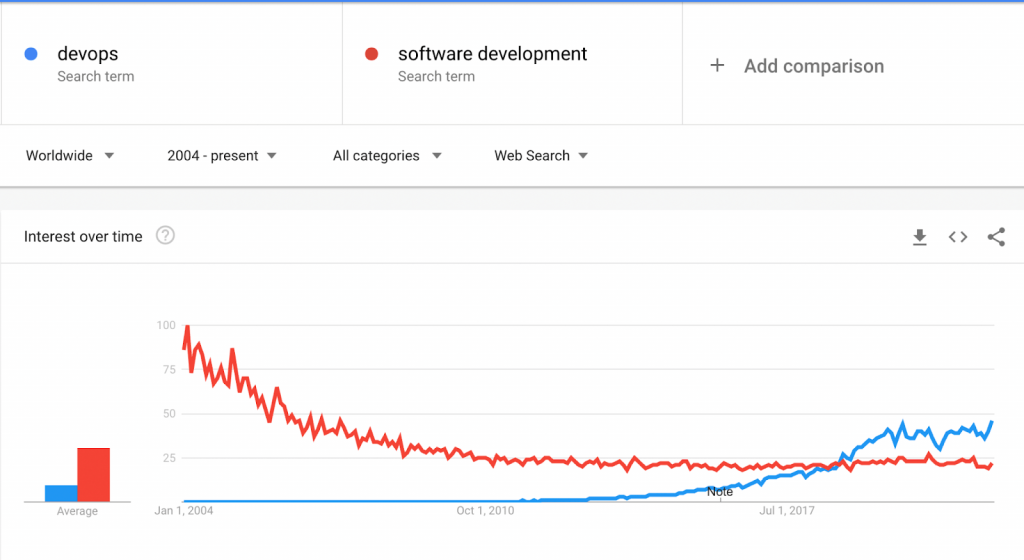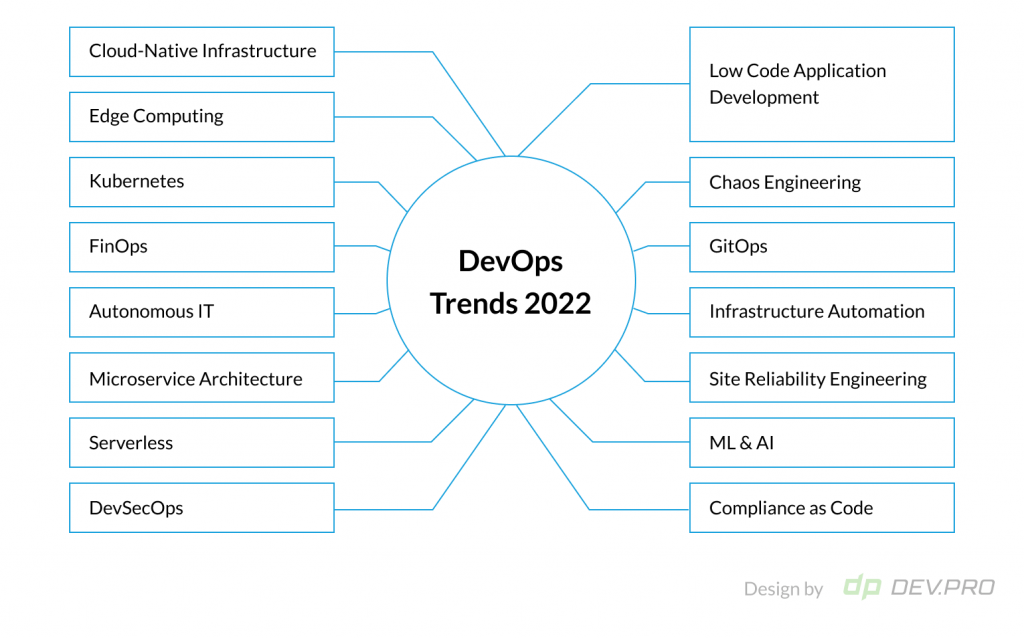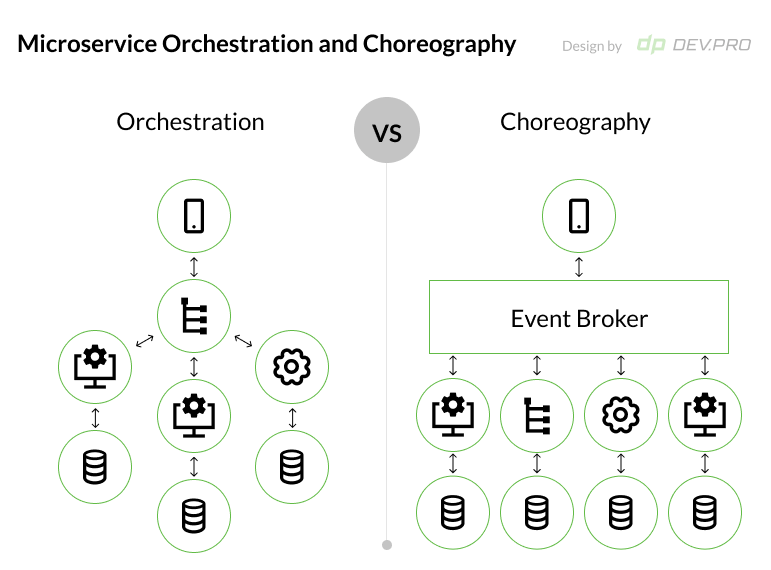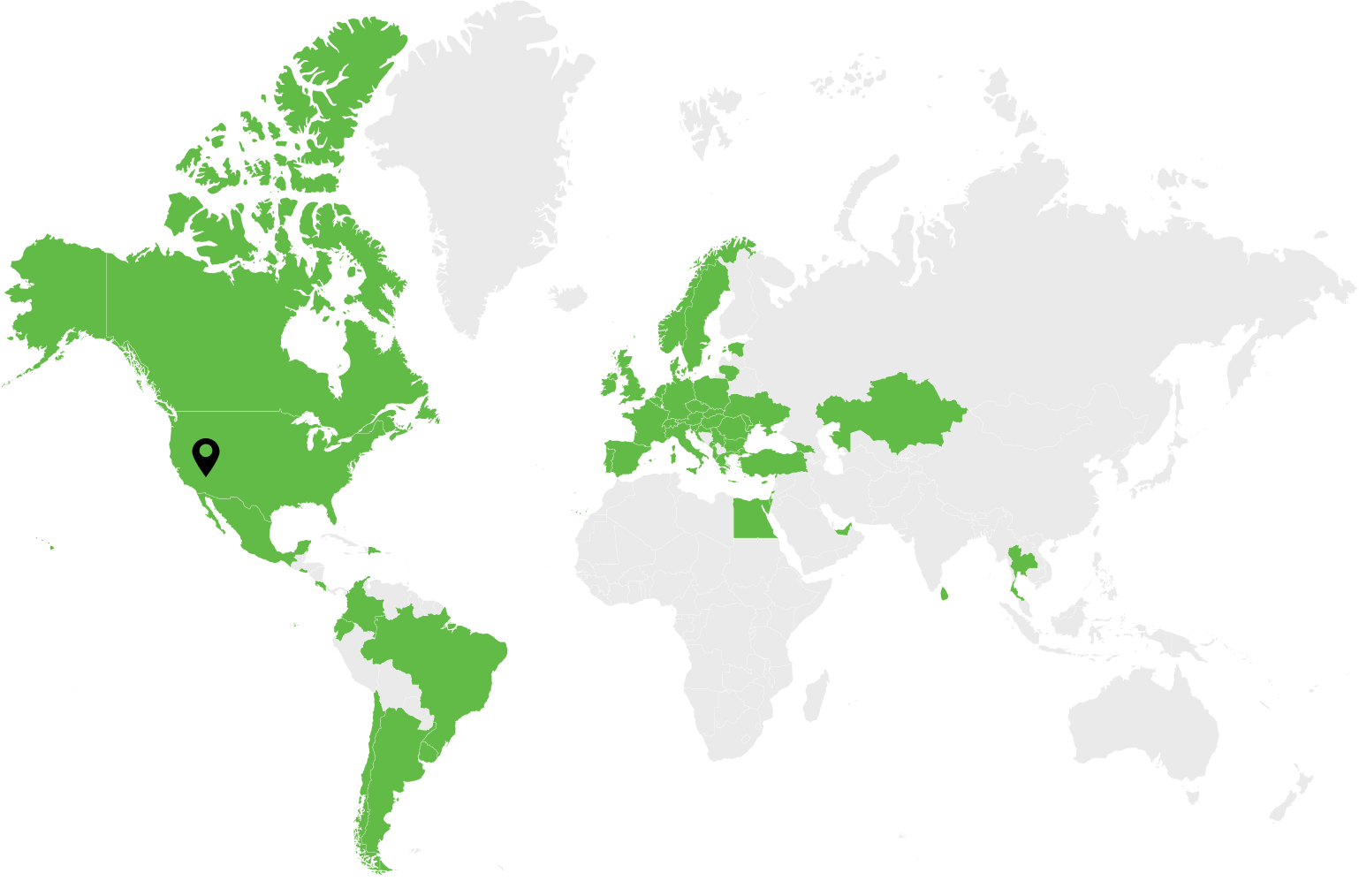DevOps Trends: The Offspring of DevOps as the New Norm
DevOps has reached the levels of popularity enough to outperform the omnipresent “software development” on Google Trends. With the first Google mentions dating back to 2011, DevOps has now turned into the gold standard for software project execution.
Naturally, the latest DevOps trends will define how tech products are built in the years to come, so we turned to Dev.Pro’s tech experts for their insider insights.

Top DevOps Trends of 2022: The New, The Old, and The Eternal
DevOps has reshaped how developers and operations work together. This collaborative culture has proven so efficient that it spun off another two collaborative frameworks: DevSecOps and FinOps.
However, all terms and methodologies of the DevOps industry are being coined and crystallized as this is being written. Puppet’s State of DevOps 2021 revealed that a DevOps team can refer to different formats: from a group of people that are a sum of Dev + Ops, to a specific mediator group that encourages and facilitates cooperation between operations and development.
Similarly, when we talk about concepts and technical phenomena that comprise the backbone of DevOps, they are still fluid and are a work-in-progress. The recap below is valid for DevOps Trends in 2022.
Cloud-Native Infrastructure
Cloud migration is mundanely performed by many companies, which shift their networks onto cloud environments: system after system. However, all major SaaS solutions developed in the early 2020s are designed as cloud-native products.
Cloud-native infrastructure combines all of the most recent DevOps tools with the cloud environment so that to take advantage of cloud benefits from the earliest stages of application design. In most cases, it will also mean the use of microservices architecture, DevSecOps principles, CI/CD pipelines, and the best FinOps practices.
Edge Computing
The evolution of IoT devices and 5G technology makes edge computing the next big milestone in the development of enterprise infrastructure as we know it. A lot of data is being collected at the outskirts of the corporate networks only to go all the way to clouds to be processed: from mobile devices and sensors, to robots and laptops.
This approach makes things slow and expensive, as you need fast and powerful connections between those pieces of data-generating equipment and the compute power of the cloud. This is why local compute machines that can do some of the processing closer to the origin of data make so much sense now.
Both edge devices and edge servers can now be used to compute some of the data locally without overburdening the connectors and providing the much needed insights faster. For example, many of the manufacturing robots are produced as edge devices, with some CPU installed and are able to perform some processing locally.
Kubernetes Container Orchestration Tool
In a recent survey by the CNCF [Cloud Native Computing Foundation], Kubernetes is used or being evaluated by 96% of organizations.
This organization was formed after Google, Kubernetes’s original developer, decided to make the product open source.
This container orchestration tool helps developers reduce the manual, time-consuming, and error-prone work of managing containers across multiple environments with the help of scripts. It helps eliminate downtime by driving availability, ensures smooth scaling and aids in disaster recovery.
Kubernetes has grown from a niche technology to something utterly ubiquitous
Chris Aniszczyk
CTO, CNCF
FinOps: The DevOps Trend in 2022 and Beyond
With one of the major cloud computing benefits being cost efficiency, sometimes savings take too long to appear on the balance sheet. This is why Cloud Cost Optimization [aka FinOps or Cloud Cost Management] is making its way into the software development realm.
From cloud service vendor negotiations to choosing the right type of instances, tools for cloud cost monitoring, selecting the right storage class for your DBs, and scheduling instances — the arsenal of FinOps tools is sizable.
Read DevPro’s whitepaper on Cloud Cost Optimization to understand basic FinOps principles as well as learn the right-sizing and right-costing techniques that could help your company save sooner rather than later.

Autonomous IT
Autonomous IT suggests extensive usage of automation combined with AI and ML algorithms along the entire software development lifecycle.
Monitoring and alerting functions, disaster recovery, and testing functions can be automated and further perfected with the use of Artificial Intelligence just to start with. The more data is collected, the more precise the recommendations can be made by an AI engine. This reduces the potential downtime and escalates issues before they turn into major showstoppers.
Similarly, in DevTestOps, machine learning and artificial intelligence technologies can be trained not only to spot any known inconsistencies, but also to predict and prevent them. The evolution of autonomous IT will reduce human labor exponentially.
The final stage of such automation revolution will be its democratization, wherein IT network automation tools will have the simplicity of plug & play tools available at a monthly subscription.
Microservice Architecture as The Default For SaaS Products
While monolith is still a default mode for many enterprise-grade software products, the development of SaaS products demands microservices architecture. Loose coupling of services helps potentially massive products with scaling ambitions, grow larger quicker – with fewer resources and downtime.
Software solutions engineers have to make many critical decisions when designing a software system from scratch or upgrading it: Microservices Orchestration vs. Choreography, selecting cloud service providers and migration type, and choosing a tech stack.
However, the shift to microservices from monolith is unstoppable for SaaS systems. These products service millions of clients and can’t afford any downtime, which means they need easy scalability, and require multi-region and multi-currency payment systems.

Serverless: The Fast & Furious Computing Power for Select Uses
While serverless computing is recommended for a range of limited functions like data processing, real-time stream processing, and building the backend part of applications, its advantages make shifting these functions to serveless a matter of time.
Improved resiliency, easy content customization, better scalability and cost efficiency have prompted a fast adoption of serverless computing for those limited functions. AWS Lambda, Azure Functions, and Cloud Functions offer clients tools to quickly deploy their code without the hassle of dealing with servers.

According to GMI Insights, serverless architecture will grow in popularity. Automation and orchestration, API management, monitoring, and security functions use serverless architecture most often.
DevSecOps
DevSecOps is a natural progression in terms of handling the entire SDLC as the monolithic concept, not a step-by-step process. Just as mistakes in code take significantly more effort and money to fix at a later stage, security issues caught early or even prevented can save millions of dollars.
From design stage to alerting, monitoring, maintenance, and updates, security measures and tools need to be implemented preventively and embedded in the software product on an architectural level.
According to Gartner, cybersecurity mesh, vendor consolidation, identity-first security principles, and Breach and Attack Simulations [BAS] are the next-gen cybersecurity issues that will define DevSecOps trends.
Low Code Application Development
A 4.6X increase in speed and cost savings is a significant improvement for any industry, let alone one as competitive and time sensitive as software product development.
Low-code platforms save time, money, and human resources by offering easy-to-use visual drag & drop tools to create applications, automate workflows, or build ecommerce stores.
Even though custom mobile and app application development is the default setting for most major players, SMEs thrive on website and application builders that require no coding experience. Gartner predicted that 65% of apps will be low-code built by 2024.
Low-code platforms like Apple Pie, Airtable, and Quixy help build mobile apps, websites, and chatbots with no developer experience.
Chaos Engineering: Preventive Vulnerability Detection
Treating your production environment as a sacred cow and doing all of the testing in a staging environment is the opposite of chaos engineering. Not only do devotees of chaos engineering love to experiment live with the systems that are serving customers, but they inflict damage to networks, infra, and apps on purpose too. Resilience testing is another term that describes this approach.
System sabotage techniques range from latency injection to deliberate server shutdowns. There are an array of tools that help wreak havoc, including Chaos Monkey, Chaos Machine, and Gremlin. With the proliferation of microservices, where systems are loosely coupled and downtime in one system does not equal failure of the entire network, chaos engineering helps find weaker spots at lower costs.
Embracing GitOps: Infrastructure as Code Done Right
GitOps is another of the latest trends in DevOps that adds efficiency, resiliency, security, and more control to your SDLC.
By using Git as the single point of truth, developers get version control, ability to create pull and push requests, and a better CI/CD pipeline. This Git-enabled X as code set up allows you to enhance the developing experience, reduce cost, and create a repeatable and codified IaC.
Infrastructure Automation
Automation of tedious repetitive tasks serves to reduce human labor, errors, and cost. In the complex, ever-changing, and ever-growing environment of modern IT infrastructure, automation becomes increasingly vital.
While it’s not possible to automate all of the processes, tasks like provisioning, capacity planning, and spinning up new workloads, cost containment can be simplified through IT system automation. Transference of duties from manual to machine-performed is possible irrespective of the deployment environments your systems use. Infrastructure automation is doable for self-service cloud, multi-cloud, Kubernetes, and network automation.
The tradeoffs are worth the effort and investment. They include cost efficiency, agility, and increased efficiency and accuracy. Terraform, Ansible, Consul, and Packer are the popular automation tools favored by IT experts.
Site Reliability Engineering [SRE]
Site Reliability Engineering [SRE] is nearly a two-decade-old notion, as the first SRE department was founded at Google by Ben Treynor Sloss in 2003. How come it is still among the top DevOps industry trends in 2022?
The DevOps teams that do all the coding and development of features in close cooperation with marketing found that the institutional knowledge of the SRE teams allows for a more reliable, resilient, and sustainable code.
This is why the contribution of the SRE team to the process of code deployment is invaluable when it comes to automation, observability, defining error budgets and pursuing no more reliability than is necessary. Optimization of the code, through the vivisection of failures through logging, monitoring, and RCA allows for more sustainable and more cost efficient code.
ML & AI: The Amplifier of DevOps
DevOps enables a SDLC that is continuous at all stages, from build to testing, while staying agile at the same time. With the number of data produced by the IT systems and an extensive IT automation toolchain, the next-gen of DevOps requires powerful computing algorithms.
This is why the integration of technologies like big data, machine learning and artificial intelligence is one of the top DevOps trends 2022. These technologies allow you to process aggregated terabytes of data so that you can find patterns and use them for further predictive analysis.
ML allows for the detection of anomalies, errors, antipatterns, and malicious activities based on historically known patterns, reducing or totally preventing potential downtime and failures.
The more complex an IT infrastructure grows, the more likely it is that ML and AI will benefit and facilitate its smooth operation and automation going forward.
DevOps Latest Trends: Compliance as Code
Compliance as a code becomes critical for many industries, specifically for those where PII and sensitive payment details are part of the daily transaction cycle. GRC [Government, Risk management and Compliance] gets more stringent and time consuming as PCI-DSS, PII, GDPR, NIST, CCPA are only a few of the complex frameworks to comply with.
This is why more companies turn to using code instead of conducting manual checks and audits for GRC purposes. In such a setup, automatic checks of compliance rules happen according to the schedule of when there is a specific change in the environment. Not only does this approach facilitate a quicker SDLC, it also eliminates human errors, and helps reduce fines and downtime.
Future of DevOps
DevOps trends are a mix of the decade-old tried and tested practices, like SRE and serverless, and newer developments like FinOps, edge computing, and DevSecOps.
It is clear that cloud-native applications, FinOps, IoT, ML and AI will be the shaping power of the DevOps industry going forward, allowing us to make cheaper, more reliable products faster.
Depending on the size of your software development product, you might only need half a dozen of these DevOps best practices. At the same time, enterprise solutions with multi-cloud environments will gain immediate benefits from adopting each of these techniques. Moreover, DevPro’s vast software development portfolio proves that in many cases these technical approaches amplify each other, producing a synergistic effect.
Dev.Pro is a software development partner that has served US clients for over a decade in fast-paced industries like Restaurant Tech, HealthTech, Retail, FinTech, EduTech. We keep an eye on everything recent in DevOps to offer timely changes for your clients and help you gain a competitive advantage of the recent trends’ early adopters. Speak to our team to see if we can help drive your tech product in accordance with the latest tech developments.


